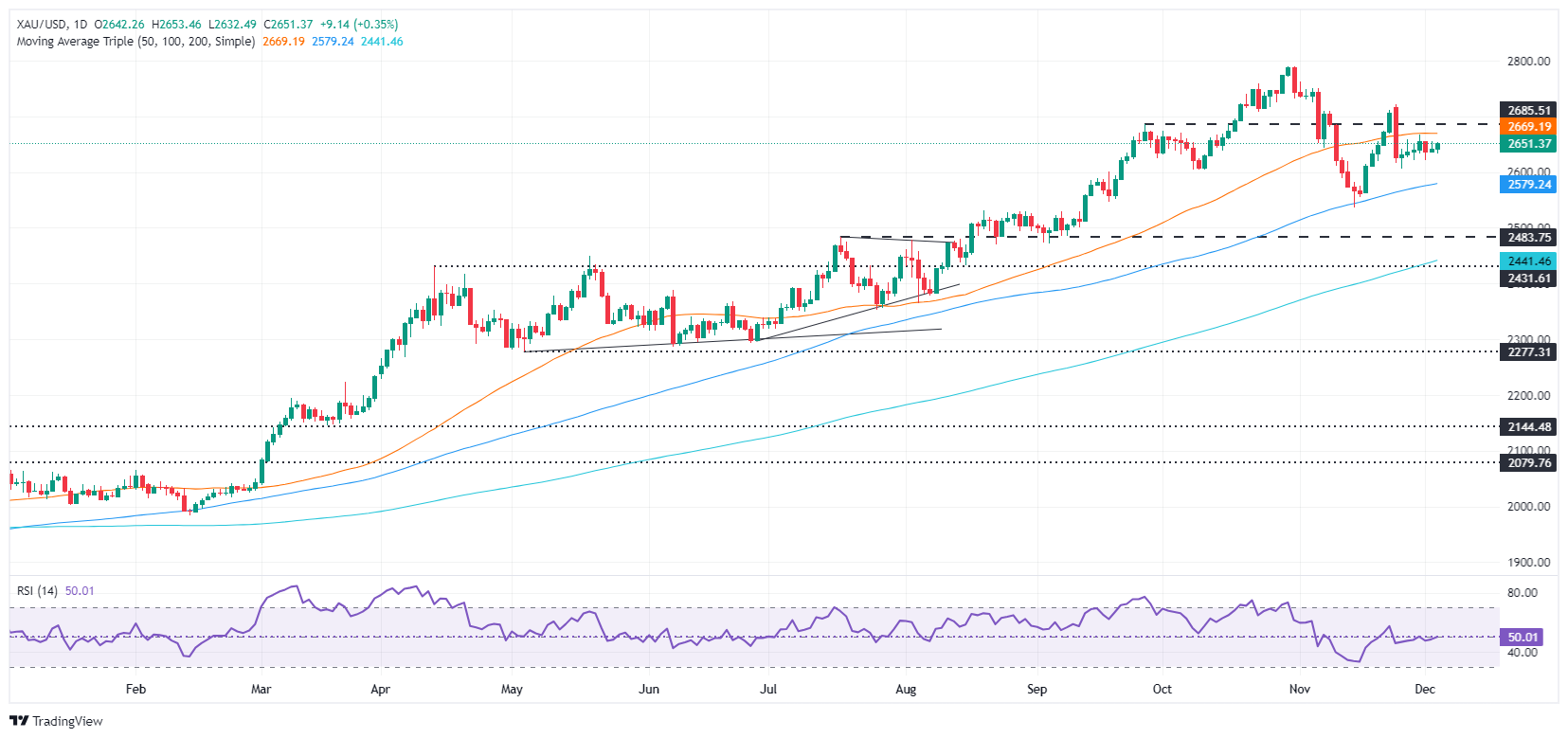- Analytics
- News and Tools
- Market News
- Gold price edges higher as ADP falls shorts of expectations
Gold price edges higher as ADP falls shorts of expectations
- Gold prices see slight increase, stabilizing at around $2,650 following subpar US ADP employment data.
- November's ADP report shows a hiring slowdown, with only 146,000 jobs added versus the 150,000 expected.
- Fed officials maintain cautious stance on rate cuts amid solid but slowing employment growth and sticky inflation.
Gold prices consolidate at around $2,650 for the seventh consecutive day, posts modest gains of over 0.20% after US jobs data revealed that private hiring dipped, missing economists forecasts. At the time of writing, XAU/USD trades at $2,648.
XAU/USD gains modestly after weaker-than-expected November job growth
Automatic Data Processing (ADP) revealed that companies in the US added 146,000 people to the workforce in November, below estimates of 150,000. Worth noting that the numbers were also below the revised numbers of the previous month, with October figures coming at 184,000, down from 238,000 reported a month ago.
Today’s data, coupled with the latest Job Openings and Labor Turnover Survey (JOLTS) data revealed on Tuesday, confirms that the labor market remains solid. Federal Reserve policymakers, who shifted their dual-mandate priority towards maximum employment, leaving aside price stability, can be relieved that the economy remains solid.
Recently, inflation has proved to be stickier than expected. In the last three months, the US disinflation process stalled, and despite ticking up a tenth, prices remain far from hitting the Fed’s 2% goal.
In the meantime, Fed speakers cross the wires. St. Louis Fed President Alberto Musalem said that time might be near to slow or pause rate cuts. Musalem added the labor market is consistent with full employment and that inflation can converge toward 2% in the next two years.
During the day, the US economic docket will feature Fed Chair Jerome Powell’s speech at around 18:45 GMT.
Gold Price Forecast: Technical outlook
Gold’s remain upward biased, yet remains subdued at around the $2,600-$2,650 for the last seven days. Capped on the upside by the 50-day Simple Moving Average (SMA) at $2,668, if its broken this would expose $2,700. On further strength, bulls can test the year-to-date (YTD) high at $2,790. Conversely, bears stepping in, could drag XAU/USD to $2,600, followed by the 100-day SMA at $2,578.
Gold FAQs
Gold has played a key role in human’s history as it has been widely used as a store of value and medium of exchange. Currently, apart from its shine and usage for jewelry, the precious metal is widely seen as a safe-haven asset, meaning that it is considered a good investment during turbulent times. Gold is also widely seen as a hedge against inflation and against depreciating currencies as it doesn’t rely on any specific issuer or government.
Central banks are the biggest Gold holders. In their aim to support their currencies in turbulent times, central banks tend to diversify their reserves and buy Gold to improve the perceived strength of the economy and the currency. High Gold reserves can be a source of trust for a country’s solvency. Central banks added 1,136 tonnes of Gold worth around $70 billion to their reserves in 2022, according to data from the World Gold Council. This is the highest yearly purchase since records began. Central banks from emerging economies such as China, India and Turkey are quickly increasing their Gold reserves.
Gold has an inverse correlation with the US Dollar and US Treasuries, which are both major reserve and safe-haven assets. When the Dollar depreciates, Gold tends to rise, enabling investors and central banks to diversify their assets in turbulent times. Gold is also inversely correlated with risk assets. A rally in the stock market tends to weaken Gold price, while sell-offs in riskier markets tend to favor the precious metal.
The price can move due to a wide range of factors. Geopolitical instability or fears of a deep recession can quickly make Gold price escalate due to its safe-haven status. As a yield-less asset, Gold tends to rise with lower interest rates, while higher cost of money usually weighs down on the yellow metal. Still, most moves depend on how the US Dollar (USD) behaves as the asset is priced in dollars (XAU/USD). A strong Dollar tends to keep the price of Gold controlled, whereas a weaker Dollar is likely to push Gold prices up.
© 2000-2025. All rights reserved.
This site is managed by Teletrade D.J. LLC 2351 LLC 2022 (Euro House, Richmond Hill Road, Kingstown, VC0100, St. Vincent and the Grenadines).
The information on this website is for informational purposes only and does not constitute any investment advice.
The company does not serve or provide services to customers who are residents of the US, Canada, Iran, The Democratic People's Republic of Korea, Yemen and FATF blacklisted countries.
Making transactions on financial markets with marginal financial instruments opens up wide possibilities and allows investors who are willing to take risks to earn high profits, carrying a potentially high risk of losses at the same time. Therefore you should responsibly approach the issue of choosing the appropriate investment strategy, taking the available resources into account, before starting trading.
Use of the information: full or partial use of materials from this website must always be referenced to TeleTrade as the source of information. Use of the materials on the Internet must be accompanied by a hyperlink to teletrade.org. Automatic import of materials and information from this website is prohibited.
Please contact our PR department if you have any questions or need assistance at pr@teletrade.global.
















